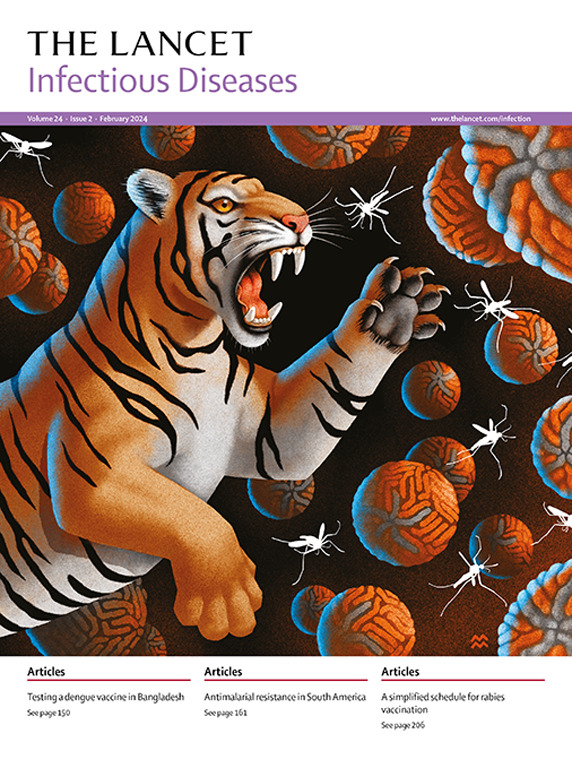Comparative assessment of immunogenicity and safety of recombinant influenza vaccine in children, adolescents, and adults: results from a phase 3, immunobridging, open-label, non-randomised study
IF 36.4
1区 医学
Q1 INFECTIOUS DISEASES
引用次数: 0
Abstract
Background
The recombinant influenza vaccine (RIV) is licensed for adults older than 18 years but is not approved for paediatric groups. This study aimed to demonstrate the non-inferior immune responses and safety of RIV in participants aged 9–17 years compared with adults aged 18–49 years.Methods
This was a phase 3, non-randomised, immunobridging, open-label, uncontrolled study conducted at 36 centres in Europe and the USA during the 2022–23 northern hemisphere influenza season. The main exclusion criteria were receipt of an influenza vaccine up to 6 months before enrolment and receipt of any other vaccines within 4 weeks before or after study intervention (except for COVID-19 vaccination, which was allowed at least 2 weeks before or after enrolment). Healthy participants aged 9–49 years received a single dose of quadrivalent RIV and were followed up for 6 months on days 9, 29, and 181. Haemagglutination inhibition (HAI) assays to assess immunogenicity were used to test blood samples obtained at baseline and day 29. The primary outcome was the non-inferiority of immune response at day 29 as assessed by HAI titre ratios and differences in seroconversion rates between the two age groups. The non-inferiority of a geometric mean titre was demonstrated if the lower limit of the two-sided 95% CI of the geometric mean titre (GMT) ratio was above 0·667 for each of the four strains of virus. Similarly, the non-inferiority of seroconversion was demonstrated if the lower limit of the two-sided 95% CI was −10% or above for each of four strains. Safety was monitored throughout the study. This study was registered at ClinicalTrials.gov (NCT05513053) and is complete.Findings
Between Oct 27, 2022, and May 1, 2023, a total of 1308 participants were enrolled, all of whom attended the first study visit. 1299 participants (99%) received the study vaccine (641 participants [49%] in the age 9−17 years group and 658 participants [51%] in the age 18−49 years group). The mean age of participants in the age 9−17 years group was 13·0 years (SD 2·5) and was 34·3 years (9·2) in the age 18−49 years group. Overall, 707 participants (54%) were female and 601 participants (46%) were male. Most of the participants were White (1003 [77%] of 1308); the next largest category was Black or African American (255 [19%]); 149 (11%) participants identified as Hispanic or Latino. The HAI GMT ratio between the paediatric and adult groups at day 29 in the per-protocol analysis set was 2·0 (95% CI 1·7 to 2·3), 3·3 (2·8 to 3·9), 1·6 (1·4 to 1·8), and 1·2 (1·1 to 1·4) for A/H1N1, H3N2, B/Victoria, and B/Yamagata, respectively. Differences in seroconversion between the groups were 1·9 (−2·8 to 6·6), −0·6 (−4·4 to 3·2), 3·3 (−1·6 to 8·1), and 14·3 (9·2 to 19·3) for each of the four strains, respectively. The safety profile was comparable in both age groups, except for solicited reactions within 7 days post-vaccination that were fewer in children and adolescents (274 [44%] of 618; 95% CI 40 to 48) than in adults (336 [53%] of 635; 49 to 57). No related serious adverse events, deaths, or adverse events of special interest were reported.Interpretation
RIV4 induced non-inferior immune responses in the participants aged 9–17 years compared with those aged 18–49 years. No safety concerns were reported.Funding
Sanofi.重组流感疫苗在儿童、青少年和成人中的免疫原性和安全性的比较评估:来自免疫桥接、开放标签、非随机的3期研究结果
重组流感疫苗(RIV)已被批准用于18岁以上的成年人,但未被批准用于儿科群体。本研究旨在证明9-17岁的参与者与18-49岁的成年人相比,RIV的非劣免疫反应和安全性。方法:这是一项3期、非随机、免疫桥接、开放标签、非对照研究,于2022-23年北半球流感季节在欧洲和美国的36个中心进行。主要排除标准是在入组前6个月接种流感疫苗,并在研究干预前后4周内接种任何其他疫苗(COVID-19疫苗除外,在入组前或后至少2周接种)。9 - 49岁的健康参与者接受单剂量四价RIV,并在第9、29和181天随访6个月。采用血凝抑制(HAI)法评估免疫原性,对基线和第29天采集的血液样本进行检测。主要结果是第29天免疫应答的非劣效性,通过HAI滴度比和两个年龄组之间血清转化率的差异来评估。如果四株病毒的几何平均滴度(GMT)比值的双侧95% CI下限均大于0.667,则证明几何平均滴度的非劣效性。同样,如果四种菌株的双侧95% CI下限均为- 10%或以上,则证明血清转化的非劣效性。在整个研究过程中都对安全性进行了监测。该研究已在ClinicalTrials.gov注册(NCT05513053),并且已经完成。在2022年10月27日至2023年5月1日期间,共有1308名参与者入组,所有参与者都参加了第一次研究访问。1299名参与者(99%)接种了研究疫苗(9 - 17岁组641名参与者[49%],18 - 49岁组658名参与者[51%])。9 ~ 17岁组参与者的平均年龄为13.0岁(SD为2.5),18 ~ 49岁组参与者的平均年龄为34.3岁(SD为9.2)。总的来说,707名参与者(54%)是女性,601名参与者(46%)是男性。大多数参与者为白人(1308人中有1003人[77%]);其次是黑人或非裔美国人(255人[19%]);149名(11%)参与者被确定为西班牙裔或拉丁裔。在每个方案分析集中,第29天儿科组和成人组之间的HAI GMT比值分别为2.0 (95% CI为1.7 ~ 2.3)、3.3 (95% CI为2.8 ~ 3.9)、1.6(1.4 ~ 1.8)和1.2 (1.1 ~ 1.4),A/H1N1、H3N2、B/Victoria和B/Yamagata。4株血清转化率分别为1·9(−2·8 ~ 6·6)、−0·6(−4·4 ~ 3·2)、3·3(−1·6 ~ 8·1)和14·3(−9·2 ~ 19·3)。除了儿童和青少年在接种疫苗后7天内的征求性反应较少(618例中有274例[44%];95% CI 40 ~ 48)比成人(635例中的336例[53%];49 - 57)。未报告相关的严重不良事件、死亡或特别关注的不良事件。与18-49岁的参与者相比,riv4在9-17岁的参与者中诱导了非劣势免疫反应。没有安全问题的报道。
本文章由计算机程序翻译,如有差异,请以英文原文为准。
求助全文
约1分钟内获得全文
求助全文
来源期刊

Lancet Infectious Diseases
医学-传染病学
CiteScore
60.90
自引率
0.70%
发文量
1064
审稿时长
6-12 weeks
期刊介绍:
The Lancet Infectious Diseases was launched in August, 2001, and is a lively monthly journal of original research, review, opinion, and news covering international issues relevant to clinical infectious diseases specialists worldwide.The infectious diseases journal aims to be a world-leading publication, featuring original research that advocates change or sheds light on clinical practices related to infectious diseases. The journal prioritizes articles with the potential to impact clinical practice or influence perspectives. Content covers a wide range of topics, including anti-infective therapy and immunization, bacterial, viral, fungal, and parasitic infections, emerging infectious diseases, HIV/AIDS, malaria, tuberculosis, mycobacterial infections, infection control, infectious diseases epidemiology, neglected tropical diseases, and travel medicine. Informative reviews on any subject linked to infectious diseases and human health are also welcomed.
 求助内容:
求助内容: 应助结果提醒方式:
应助结果提醒方式:


